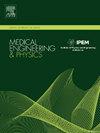Impact of transforaminal lumbar interbody fusion on rod load: a comparative biomechanical analysis between a cadaveric instrumentation and simulated bone fusion
IF 1.7
4区 医学
Q3 ENGINEERING, BIOMEDICAL
引用次数: 0
Abstract
Background
Recent research has demonstrated the potential of implant load monitoring to assess posterolateral spinal fusion in a sheep model. This study investigated whether such a system could monitor bone fusion after interbody fusion surgery by biomechanically testing of human cadaveric lumbar spines in two states: following a transforaminal lumbar interbody fusion (TLIF) procedure and after simulating bone fusion.
Methods
Eight human cadaveric spines underwent a TLIF procedure at L4-L5. An implantable sensor system was attached to one rod, while two strain gauges were attached to the contralateral rod (dorsally and ventrally) to derive implant load changes during unconstrained flexion-extension (FE), lateral bending (LB) and axial rotation (AR) motion. The specimens were retested after simulating bone fusion at L4-L5. Range of motion (ROM) of L4-L5 was measured during each loading mode.
Results
ROM decreased in the simulated bone fusion state in all loading directions (p ≤ 0.002). Compared to the TLIF motion, the remnant motion after simulated fusion was 53 ± 21 % in FE, 40 ± 12 % in LB, and 49 ± 16 % in AR. In both states, measured strain on the posterior instrumentation was highest during LB motion. All sensors detected a significant decrease in load-induced rod strain after simulated bone fusion in LB (p ≤ 0.002). The strain measured by the implantable strain sensor, the dorsal strain gauge, and the ventral strain gauge decreased to 49 ± 12 %, 49 ± 17 %, and 54 ± 17 %, respectively.
Conclusion
Rod load measured via strain sensors can monitor fusion progression after a TLIF procedure when measured during isolated LB of the lumbar spine. This study provides the basis for further development and understanding of in vivo implant load data.
经椎间孔腰椎椎体间融合对棒负荷的影响:尸体内固定和模拟骨融合的生物力学比较分析
最近的研究已经证明了植入物负荷监测在羊模型中评估后外侧脊柱融合的潜力。本研究通过对经椎间孔腰椎椎体间融合术(TLIF)和模拟骨融合术两种状态下的人尸体腰椎进行生物力学测试,研究了该系统是否可以监测椎间融合术后的骨融合。方法8根人尸体脊柱在L4-L5行tliff手术。植入传感器系统连接在一根杆上,而两个应变片连接在对侧杆(背侧和腹侧)上,以获得无约束屈伸(FE)、侧向弯曲(LB)和轴向旋转(AR)运动时种植体负载的变化。在L4-L5处模拟骨融合后重新测试标本。在每种加载模式下测量L4-L5的运动范围(ROM)。结果模拟骨融合状态各加载方向rom均降低(p≤0.002)。与TLIF运动相比,模拟融合后FE的残余运动为53±21%,LB为40±12%,AR为49±16%。在两种状态下,LB运动时测得的后路内固定应变最高。所有传感器均检测到LB模拟骨融合后负载诱导棒应变显著降低(p≤0.002)。植入式应变传感器、背侧应变片和腹侧应变片测得的应变分别降至49±12%、49±17%和54±17%。结论通过应变传感器测量的棒载荷可以监测TLIF手术后的融合进展。本研究为进一步发展和理解体内植入物负荷数据提供了基础。
本文章由计算机程序翻译,如有差异,请以英文原文为准。
求助全文
约1分钟内获得全文
求助全文
来源期刊

Medical Engineering & Physics
工程技术-工程:生物医学
CiteScore
4.30
自引率
4.50%
发文量
172
审稿时长
3.0 months
期刊介绍:
Medical Engineering & Physics provides a forum for the publication of the latest developments in biomedical engineering, and reflects the essential multidisciplinary nature of the subject. The journal publishes in-depth critical reviews, scientific papers and technical notes. Our focus encompasses the application of the basic principles of physics and engineering to the development of medical devices and technology, with the ultimate aim of producing improvements in the quality of health care.Topics covered include biomechanics, biomaterials, mechanobiology, rehabilitation engineering, biomedical signal processing and medical device development. Medical Engineering & Physics aims to keep both engineers and clinicians abreast of the latest applications of technology to health care.
 求助内容:
求助内容: 应助结果提醒方式:
应助结果提醒方式:


